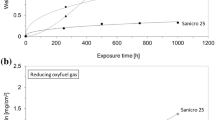Abstract
The major use of high-temperature steel alloys in gasifiers is in heat exchangers for cooling hot syngas, consisting mainly of CO and H2 with lesser amounts of H2O and CO2 and minor quantities of H2S and HCl. Metal temperatures range from 250 to 600°C, gas temperatures from 250 to 1200°C. Because of rapid cooling the composition of the gas does not change with temperature. Therefore the gas is not in equilibrium at the metal surface. Calculations show that such gases have lower oxygen and sulfur pressures than equilibrated gases at the same temperature. This makes the results of previous laboratory studies less appropriate for predicting mixed oxidant corrosion in gasifiers. For this reason the present study was carried out using nonequilibrium gas mixtures, similar to gases, produced in entrained-slagging gasifiers. Most corrosion experiments were carried out at 540°C, as this is a common temperature for superheaters and hot-gas cleanup systems. Iron-base model alloys containing 35% Ni, 20% Cr, and various minor alloying additions were studied. Three corrosion regimes were identified over the range of conditions studied, depending on the sulfur-to-oxygen pressure ratio of the gas and the alloy composition. At high PS 2/PO 2 ratios a somewhat protective FeCr2S4 scale formed on all alloys. Below this layer internal oxidation and sulfidation occurred at a slow rate. At lower PS 2/PO 2 ratios nonprotective Fe(Ni, Cr)S external scales formed. These allow rapid internal oxidation of the chromium in the alloy, resulting in high corrosion rates. Under the same conditions very low corrosion rates are obtained when silicon is added to the alloy, because the presence of SiO2 precipitates makes the internal-oxidation layer protective. Thus, the same corrosion model is operative in all three corrosion regimes: external sulfidation of iron and nickel, together with internal oxidation of chromium and other strong-oxide formers.
Similar content being viewed by others
References
W. T. Bakker,Mater. High Temp. 11, 81 (1993).
W. T. Bakker, J. A. Bonvallet, and J. H. W. de Wit,Proc. High Temp. Corrosion 3, R. Streiffet al., eds. (Les Editions de Physique, 1993), p. 731.
R. C. John, W. C. Fort III, and R. A. Tait,Mater. High Temp. 11, 124 (1993).
I. G. Wrightet al., Proc. Int. Workshop on High Temperature Corrosion, Gobrish, Germany, 1994.
R. A. Perkins, EPRI Report GS-6971, EPRI, Palo Alto, 1990.
R. A. Perkins and S. J. Vonk, EPRI Report FP-1280, 1979.
K. Natesan, inProc. High Temperature Corrosion, R. A. Rapp, ed. (NACE, 1981), p. 336.
H. Schüster,Allianz Berichte 16, 28 (1971).
C. Wagner,Z. Electrochem. 63, 772 (1959).
R. A. Perkins and G. H. Meier,JOM 42, 17 (1990).
W. T. Bakker, EPRI Report TR-104228.
P. K. Kofstad and A. Z. Hed,J. Electrochem. Soc. 116, 224 (1969).
G. C. Wood and T. Hodgkiess,J. Electrochem. Soc. 113 (1966).
Author information
Authors and Affiliations
Rights and permissions
About this article
Cite this article
Bakker, W.T. Mixed oxidant corrosion in nonequilibrium gasifier environments. Oxid Met 45, 487–505 (1996). https://doi.org/10.1007/BF01046848
Received:
Revised:
Issue Date:
DOI: https://doi.org/10.1007/BF01046848




